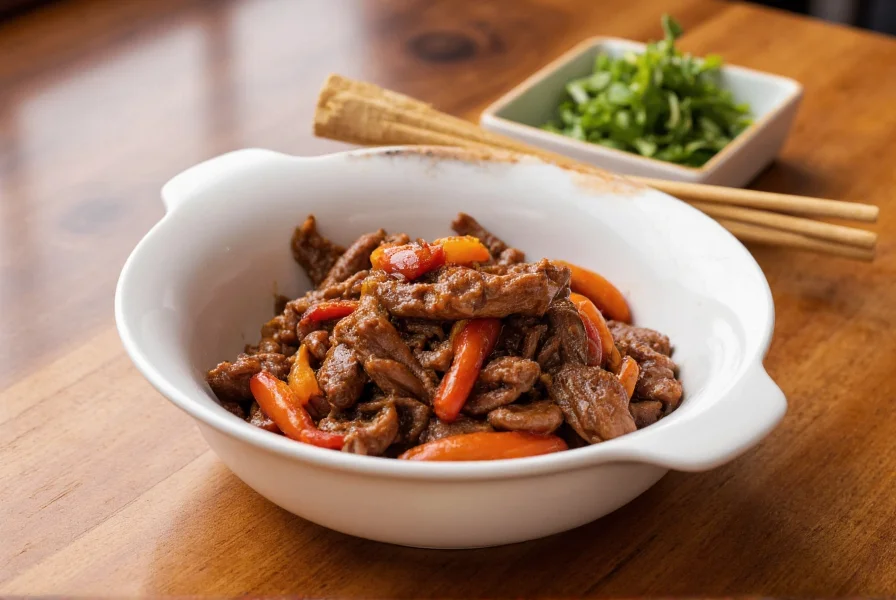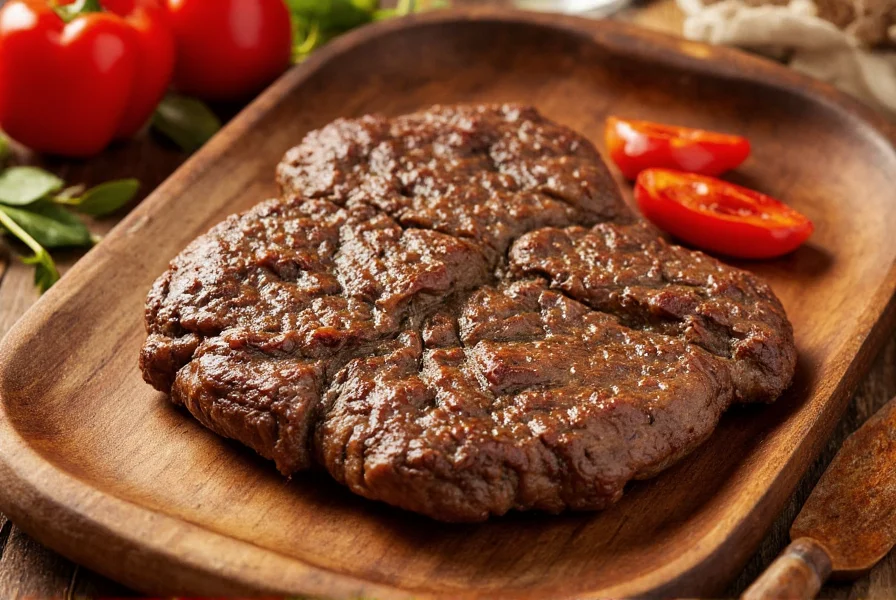The authentic old fashioned pepper steak recipe features thinly sliced beef sirloin stir-fried with bell peppers and onions in a rich brown sauce made from beef broth, soy sauce, and Worcestershire sauce. This classic American-Chinese dish originated in the 1950s-60s and differs from modern versions by using simple ingredients without cornstarch-heavy sauces or exotic additions. The traditional preparation involves quick high-heat cooking to maintain the beef's tenderness while creating a glossy, flavorful sauce that coats the ingredients perfectly.
Pepper steak represents one of the most beloved dishes from the golden age of American-Chinese cuisine. Before fusion cooking and modern techniques transformed restaurant menus, this straightforward yet satisfying dish graced dinner tables across America. Understanding what makes a pepper steak recipe truly "old fashioned" requires examining both the ingredients and cooking methods that defined mid-20th century Chinese-American cooking.
The History Behind Old Fashioned Pepper Steak
Pepper steak emerged during the 1950s when Chinese immigrants adapted traditional cooking techniques to American ingredients and tastes. Unlike authentic Chinese dishes, this creation featured more meat than vegetables and a thicker, sweeter sauce that appealed to Western palates. The "old fashioned" version specifically refers to recipes from this era that haven't incorporated modern modifications like oyster sauce, hoisin, or excessive sugar.
What distinguishes vintage pepper steak from contemporary versions? Traditional recipes relied on basic pantry staples rather than specialty Asian ingredients. The sauce consisted primarily of beef broth, soy sauce, Worcestershire sauce, and a simple cornstarch slurry—never the complex blends common today. The beef was typically sirloin or round steak, sliced by hand rather than purchased pre-sliced.
Essential Ingredients for Authentic Preparation
Creating a genuine old fashioned pepper steak requires attention to ingredient selection. Modern recipes often substitute ingredients that weren't commonly available in mid-century American kitchens. For true authenticity, stick to these traditional components:
| Traditional Ingredient | Modern Substitution to Avoid | Why It Matters |
|---|---|---|
| Beef sirloin or round steak | Flank steak or pre-sliced "stir-fry beef" | Traditional cuts were more affordable and widely available in 1950s America |
| Green bell peppers only | Mixed colored peppers or specialty peppers | Only green bell peppers were commonly used before the 1980s |
| Simple brown sauce | Complex sauce with multiple Asian ingredients | Authentic recipes used basic American pantry items |
| Hand-sliced ingredients | Pre-cut vegetables or meat | Home cooks prepared everything from scratch |
Step-by-Step Cooking Instructions
Follow these steps to recreate an authentic old fashioned pepper steak recipe exactly as it was prepared in classic American-Chinese restaurants of the 1950s and 1960s:
- Prepare the beef: Slice 1½ pounds of sirloin against the grain into ¼-inch thick strips. Pat dry thoroughly with paper towels—moisture prevents proper searing.
- Create the sauce: Whisk together 1 cup beef broth, 3 tablespoons soy sauce, 1 tablespoon Worcestershire sauce, 1 teaspoon sugar, and 2 minced garlic cloves.
- Heat the wok: Preheat your wok or heavy skillet over high heat until smoking hot. Add 2 tablespoons vegetable oil.
- Sear the beef: Working in batches, stir-fry beef for 1-2 minutes until browned but not fully cooked. Remove and set aside.
- Cook vegetables: Add ½ cup sliced onions and 1 cup sliced green bell peppers. Stir-fry 2-3 minutes until crisp-tender.
- Combine and finish: Return beef to wok, pour in sauce, and cook 2-3 minutes until sauce thickens slightly and coats ingredients.

Avoiding Common Mistakes in Traditional Preparation
Many home cooks unintentionally create modernized versions when attempting old fashioned pepper steak. These pitfalls undermine the authentic experience:
- Over-marinating the beef: Traditional recipes didn't use complex marinades. Excessive soy sauce or tenderizers creates an inauthentic flavor profile.
- Using cornstarch in the sauce: While some vintage recipes included a light cornstarch slurry, heavy thickening wasn't characteristic of the era's cooking style.
- Cooking vegetables until soft: Authentic pepper steak features crisp-tender vegetables, not the mushy textures found in some modern interpretations.
- Adding unnecessary ingredients: Oyster sauce, sesame oil, and ginger weren't standard in mid-century American-Chinese cooking.
Serving Your Old Fashioned Pepper Steak Authentically
To complete the vintage dining experience, serve your pepper steak as it would have appeared in 1950s and 1960s American-Chinese restaurants:
- Present the dish family-style in a single serving bowl rather than individual plates
- Accompany with steamed white rice (never fried rice, which was a separate menu item)
- Use simple stainless steel or ceramic serving utensils
- Pair with canned soda or bottled beer rather than specialty cocktails
The traditional presentation emphasized simplicity and practicality, reflecting the post-war American dining culture where Chinese restaurants catered to mainstream tastes.
How This Recipe Differs From Modern Versions
Contemporary pepper steak recipes often incorporate elements that weren't part of the original preparation. Understanding these differences helps maintain authenticity:
- Modern recipes frequently include ginger, which wasn't commonly used in early American-Chinese cooking
- Today's versions often feature multiple pepper colors, while traditional recipes used only green bell peppers
- Current preparations sometimes add mushrooms or other vegetables not in the original dish
- Many modern recipes use flank steak instead of the more traditional sirloin
- Contemporary versions often have thicker, glossier sauces with more complex flavor profiles
Storage and Reheating Tips for Leftovers
While old fashioned pepper steak tastes best fresh, proper storage maintains quality for leftovers:
- Cool completely before storing in airtight containers
- Refrigerate for up to 3 days—longer storage degrades the beef's texture
- Reheat gently in a skillet with a splash of broth rather than microwaving
- Avoid freezing, as the sauce separates and vegetables become mushy upon thawing
Remember that mid-century home cooks typically prepared only what would be eaten immediately, as refrigeration technology wasn't as advanced as today.
Frequently Asked Questions
What cut of beef works best for authentic old fashioned pepper steak?
Sirloin or top round steak provides the most authentic results for old fashioned pepper steak. These cuts were commonly used in mid-20th century American-Chinese restaurants because they offered good flavor at an affordable price point. Avoid tenderloin (too expensive for the era) or flank steak (not commonly used until later decades). Slice against the grain for maximum tenderness.
Why don't traditional recipes include ginger or garlic?
Early American-Chinese cooking simplified traditional Chinese recipes to use ingredients available in mid-20th century American grocery stores. Ginger wasn't widely available until later decades, and garlic was used sparingly due to its strong flavor, which many Americans found unfamiliar at the time. The classic old fashioned pepper steak relied on Worcestershire sauce for depth rather than aromatic ingredients.
Can I make this recipe without a wok?
Absolutely. While traditional Chinese restaurants used woks, home cooks in the 1950s and 1960s typically prepared pepper steak in cast iron skillets or heavy frying pans. The key is using a pan that can reach high heat quickly. A 12-inch cast iron or carbon steel skillet works perfectly for authentic old fashioned pepper steak preparation.
How did restaurants achieve that glossy sauce without cornstarch?
Traditional pepper steak sauce achieved its sheen through reduction rather than heavy thickening. Chefs would simmer the sauce briefly to concentrate flavors and create natural viscosity from the meat's collagen and the sauce ingredients. Some recipes used a light cornstarch slurry (1 teaspoon cornstarch to 2 tablespoons cold water), but never the heavy thickening common in modern versions.











 浙公网安备
33010002000092号
浙公网安备
33010002000092号 浙B2-20120091-4
浙B2-20120091-4